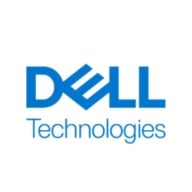

Dell PowerFlex and Dell VxFlex Ready Nodes are competing products in flexible storage and computing solutions. Dell PowerFlex seems to have the upper hand with its integration capabilities and scalability, adapting well to complex environments, while VxFlex Ready Nodes appeal to those with specific high-demand applications.
Features: Dell PowerFlex showcases scalability and seamless integration, supporting diverse hardware and software configurations. It adapts well to existing IT infrastructures and offers advanced performance tuning. Dell VxFlex Ready Nodes provide powerful performance and reliability, ideal for intensive workloads and frequent data transactions, emphasizing reliability and support for demanding environments.
Ease of Deployment and Customer Service: Dell VxFlex Ready Nodes feature a straightforward deployment model focused on a plug-and-play approach, which minimizes complexity and setup time. Their customer service is known for strong support. Dell PowerFlex has a more complex deployment process due to its broader integration capabilities, but its customer service is robust, offering comprehensive assistance during the deployment process.
Pricing and ROI: Dell PowerFlex presents a higher initial setup cost but offers strong ROI with its scalability and adaptability, favoring long-term growth. Dell VxFlex Ready Nodes have lower initial costs, delivering a faster ROI through immediate performance and reliability improvements, offering a cost-effective solution for immediate needs compared to the long-term benefits of PowerFlex.
| Product | Market Share (%) |
|---|---|
| Dell PowerFlex | 9.3% |
| Dell VxFlex Ready Nodes | 0.6% |
| Other | 90.1% |


| Company Size | Count |
|---|---|
| Small Business | 8 |
| Midsize Enterprise | 8 |
| Large Enterprise | 15 |
Dell PowerFlex is a software-defined storage infrastructure delivering modern architecture and versatile deployment for on-premises or cloud. It achieves high performance, scalable storage, and workload consolidation through advanced automation.
PowerFlex's VMware compatibility ensures seamless integration, offering flexibility in compute and storage scaling. With its hyper-converged infrastructure, it caters to AI, cloud, and database environments, providing robust automation, resilience, and security. Flexible deployment options are complemented by a single-window management system, prioritizing cost optimization. However, enhancements are needed in monitoring tools, user interface, and AI functionality. Migration from Hyper-V and licensing flexibility also require attention, while improved documentation could simplify usage. Integration with services and streamlined upgrade processes are essential.
What are the key features of Dell PowerFlex?PowerFlex is essential in industries requiring support for mission-critical workloads and large-scale applications. It is instrumental for deploying storage, compute nodes, hyper-converged infrastructure, and private clouds. The platform integrates compute, storage, and networking, optimizing performance for modern applications like AI video analytics and disaster recovery.
VxRack FLEX and VxFlex Ready Nodes, also known as the Flex family, create a server-based SAN by combining virtualization software, known as VxFlex OS, with Dell EMC PowerEdge servers to deliver flexibility, scalability, and capacity on demand. Local storage resources are combined to create a virtual pool of block storage with varying performance tiers. The platform enables you to start small (with as little as four nodes) and scale incrementally. The Flex family provides enterprise-grade data protection, multi-tenant capabilities, and add-on enterprise features such as QoS, thin provisioning, and snapshots. VxFlex OS is the key enabler and provides an unmatched combination of performance, resiliency and flexibility to address enterprise data center needs. The unique features of VxFlex OS make it an excellent complement to Kubernetes for stateful applications, such as databases, continuous integration, logging and monitoring platforms.
We monitor all HCI reviews to prevent fraudulent reviews and keep review quality high. We do not post reviews by company employees or direct competitors. We validate each review for authenticity via cross-reference with LinkedIn, and personal follow-up with the reviewer when necessary.